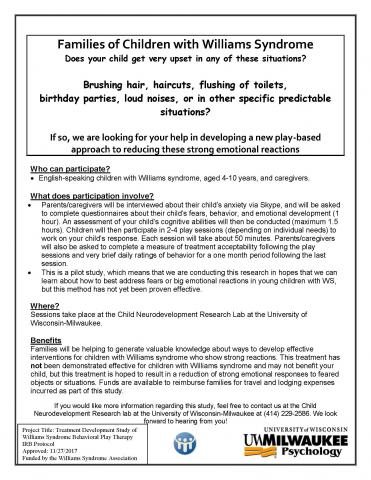 A child with Williams syndrome may dread going to school because of the possibility of a fire alarm or maybe too fearful about the sound of the hand dryer or automatic toilet flushes to go into a public bathroom at the mall or may worry about the clapping at the end of a show so much that they can’t enjoy it. Parents may avoid operating the blender or vacuum cleaner when the child is home as the child becomes too distressed or avoid birthday parties because of the singing and clapping. Hair brushing, haircuts, doctor, and dentist procedures may all be sources of massive anxiety and distress. The fear and anxiety may get in the way of getting the most out of life.
A child with Williams syndrome may dread going to school because of the possibility of a fire alarm or maybe too fearful about the sound of the hand dryer or automatic toilet flushes to go into a public bathroom at the mall or may worry about the clapping at the end of a show so much that they can’t enjoy it. Parents may avoid operating the blender or vacuum cleaner when the child is home as the child becomes too distressed or avoid birthday parties because of the singing and clapping. Hair brushing, haircuts, doctor, and dentist procedures may all be sources of massive anxiety and distress. The fear and anxiety may get in the way of getting the most out of life.
For many years, Dr. Karen Levine has been using an intervention called “Replays” to help children with Williams syndrome and other neurodevelopmental conditions learn to cope with anxiety. This approach includes play and humor to gradually decrease the child’s fear and anxiety in fearful situations. “Replays is based in a combination of gradual exposure and using the adult-child interaction plus humor, to reduce the child’s anxiety. I’ve treated many children successfully, with WS and/or other developmental challenges and anxiety, around specific phobias such as hair brushing, electronic hand dryers, or clapping at the end of Happy Birthday. Sensory sensitivities continue but the intense emotional distress and anticipatory fears can very often be treated,” says Dr. Levine. Clinically, she has found this approach very useful. While there is research support for the key components of this method to reduce a child’s anxiety, including gradual exposure, there has not been formal research about it. Until now! Through a grant provided by the Williams Syndrome Association, I am working with Dr. Levine, to refine and manualize the intervention by developing a step-by-step guide. The guide enables community clinicians to learn how to use this therapy in their work with children with Williams syndrome. We are calling this research-based version of the Replays intervention “Behavioral Play Therapy” (BPT). The BPT manual will be housed on a secure website and will include video examples of the approach to help clinicians see how to use the techniques described.
Over the next few months, we will be looking for families willing to travel to Milwaukee, WI for a few days to participate in a research study to look at how helpful the intervention is and to make video recordings of the intervention approach for use on the secure website. Dr. Levine will be in Milwaukee and will conduct the intervention sessions together with me and my staff. There are funds available for families in need of financial assistance to participate.
We are very excited about this promising approach to treating anxiety and fear in children with Williams syndrome. Doing this research is challenging, however, because of the rarity of Williams syndrome. Treatment studies usually require that children see the therapist multiple weeks in a row, thereby limiting participation to local children. That won’t work well for children with Williams syndrome. There simply aren’t enough children in any locality for a valid study. Therefore, this work is part of a new and much-needed approach that involves training community practitioners to use the intervention and track the children’s progress on the intervention, so that over time we can demonstrate that the intervention is helpful to children with Williams syndrome and their families. Working with community practitioners will allow us to generate scientific evidence that the intervention is helpful and to further refine the approach to improve its positive impact on children.
If you’d like to know more about this research, or you’d like to participate, please contact Dr. Klein-Tasman at 414-229-3060. A flyer describing the study can be found here.
--Bonnie Klein-Tasman, PhD
